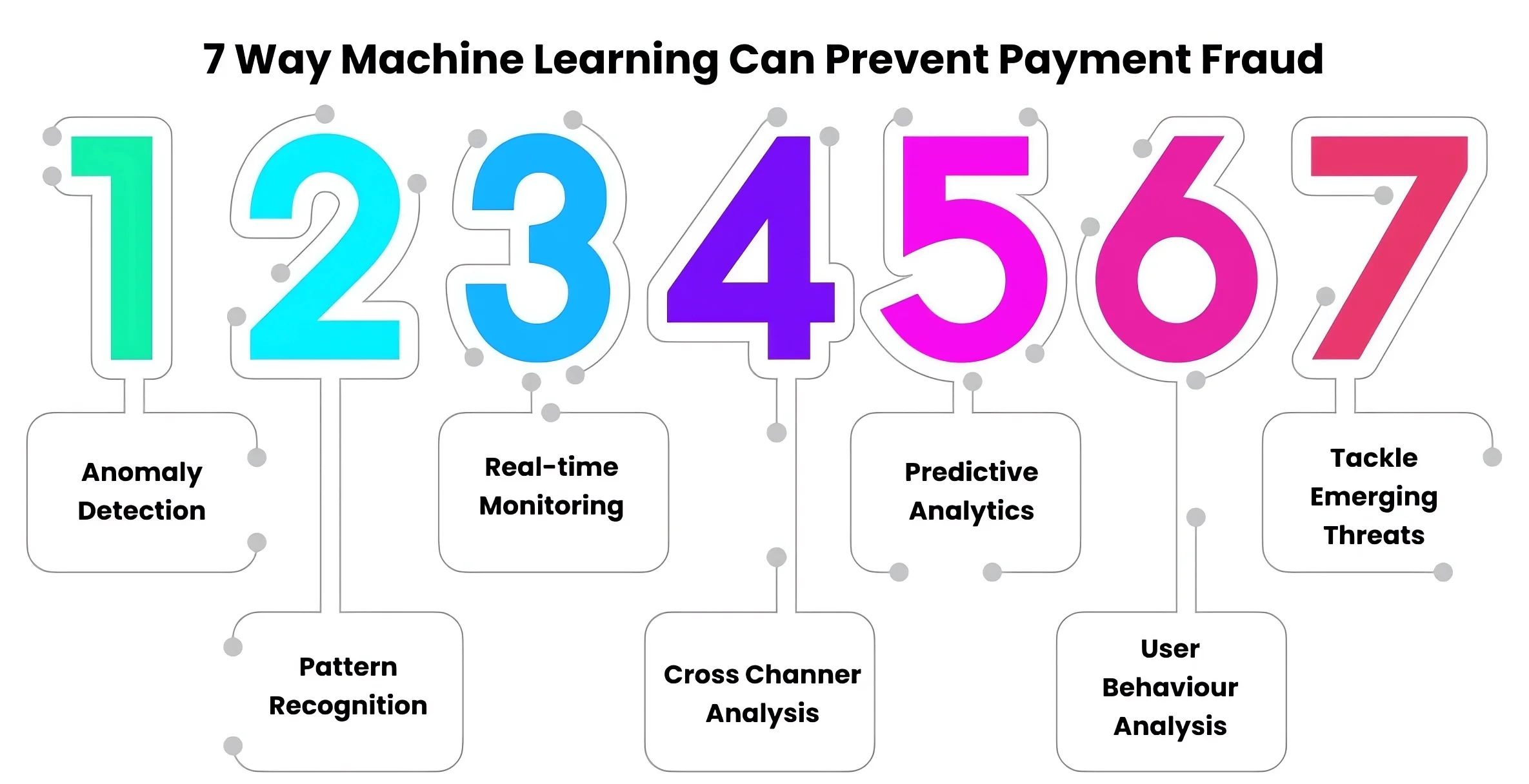As the world moves towards digital payments, the risk of fraud is also increasing. Fraudsters find new ways to steal money and data every now and then. However, the emergence of artificial intelligence (AI) helps companies fight fraud in a big way. AI can detect and stop fraud before it causes harm.
Banks and financial institutions have started using AI to make customers’ experiences better and more secure. AI systems use machine learning, language processing, and behavior analysis to spot threats quickly.
They analyze data from payments to find anything suspicious or unusual. If a transaction seems fraudulent, the AI analyses all relevant data and blocks it instantly. This protects digital payment systems from advanced fraud tricks.
AI fraud detection works round-the-clock and continually learns from new data to improve its accuracy. It can adapt to evolving fraud patterns and techniques. This makes AI an essential tool for protecting online payments and consumer data.
In this article, we aim to clarify what payment fraud is, highlight its common types, explore AI-powered detection techniques, and detail AI-driven strategies for real-time prevention. Our goal is to deepen your understanding of payment fraud and the advanced technologies used to fight it.
What is Payment Fraud?
Payment fraud is nothing but when someone illegally uses payment methods like credit cards, debit cards, digital wallets, etc. to borrow goods, services, or money fraudulently. Payment fraud presents a persistent challenge, damaging enterprises, financial institutions, and individuals worldwide.
According to a report by The Fintech Times, 60% of industry executives reported that payment fraud remained at a high level over the past 12 months, with 8% experiencing an increase. The survey also revealed that millennials have been the hardest hit by payment fraud over the past three years, with 31% falling victim to various scams.
This issue impacts almost all participants connected with monetary transactions and ecommerce. Malicious actors continually devise new methods to exploit payment systems and misappropriate funds. Concurrently, companies and consumers must remain vigilant, implementing robust security protocols to shield against fraudulent activities.
See also: Ecommerce Fraud: How to Identify Fraud in Ecommerce Stores
Common Types of Payment Fraud in 2024
When it comes to financial crimes, 2024 has seen the rise of several prevalent types of payment fraud:

- Card-Not-Present (CNP) Fraud: With the rise of ecommerce and online transactions, CNP fraud has become a significant concern. Fraudsters obtain and misuse card details to make unauthorized purchases without physically possessing the card.
- Account Takeover Fraud: In this type of fraud, cybercriminals gain unauthorized access to legitimate customer accounts by exploiting stolen credentials or using advanced techniques like credential stuffing or phishing.
- Synthetic Identity Fraud: Fraudsters create fictitious identities by combining real and fabricated personal information to open new accounts and obtain credit or payment instruments illegally.
- Authorized Push Payment (APP) Fraud: This involves tricking victims into authorizing the transfer of funds to fraudsters’ accounts through social engineering tactics or other deceptive means.
AI-Powered Fraud Detection Techniques in 2024

Today, payment fraud represents a considerable threat to both financial institutions and businesses. As the volume of online economic activity escalates and fraudsters become increasingly sophisticated, the implementation of robust anti-fraud measures for digital payments is paramount.
Fortunately, the advent of AI-powered safeguards against payment fraud equips us with potent tools to tackle this challenge head-on. Leveraging advancements in machine learning, natural language understanding, behavioral analytics, and real-time monitoring, these tools are designed to swiftly and precisely detect potential threats of fraud.
Checkout: The Role of Artificial Intelligence in CyberSecurity
How Does AI Utilize Machine Learning to Prevent Payment Fraud?
Machine learning, a subset of artificial intelligence, plays a pivotal role in current fraud detection processes. Examining vast historical data and recognizing patterns enables machine learning models to identify potential fraudulent acts. Additionally, these algorithms can adapt and evolve to combat emerging threats.

In 2024, advanced machine learning techniques such as deep learning and neural networks are being increasingly utilized. These algorithms process complex data streams in real-time. They can detect subtle irregularities and abnormal behavioral deviations, indicating possible fraudulent activities. This capability enables swifter and more precise identification of fraud.
What Role Does NLP Play in AI-Powered Fraud Detection?
Natural Language Processing (NLP) has significantly enhanced fraud detection efforts. NLP algorithms are designed to analyze and understand human language, enabling them to process unstructured data sources such as customer messages, social posts, and online reviews.
By leveraging NLP, fraud detection systems can pinpoint potential red flags, including suspicious language patterns or sentiments linked to fraudulent activities. This capability is invaluable in battling social engineering attacks and other types of fraud that rely on deceptive or manipulative language.
How Behavioral Analytics Can Identify Suspicious Payment Activities?
Understanding typical user behavior is essential in protecting against fraudulent activities. Behavioral analytics employs artificial intelligence to examine user behavior patterns meticulously. In payment fraud detection, this approach is instrumental in identifying irregularities or deviations from a user’s usual patterns, which may indicate fraudulent actions.
Artificial Intelligence systems establish baselines of normal behavior by closely tracking and analyzing user interactions, transaction histories, device usage patterns, and other behavioral data. Any deviation from these norms triggers alerts for potentially suspicious activities.
This method is particularly effective in detecting account takeover fraud, where the behavior of fraudsters significantly differs from that of the legitimate account holder.
AI-Driven Strategies for Real-Time Payment Fraud Prevention in 2024
Monitoring transactions as they happen in real time is extremely important for AI fraud detection systems in 2024. As payments get processed faster and fraudsters use trickier methods, being able to spot potential fraud threats immediately is crucial.
The AI systems constantly watch and examine all incoming payment data using machine learning algorithms, analyzing user behavior patterns, and other advanced techniques to identify anything that looks like fraud. If a suspicious transaction is flagged, the system can instantly block it, alert the companies involved, or investigate further.
When fraudulent transactions occur, rapid action is crucial to prevent financial loss. With AI fraud detection, high-risk payments can be halted immediately before completion. By functioning in real-time, this technology minimizes the impact of successful fraud attempts. Its instantaneous response is especially valuable for mitigating potential monetary damages.
Let’s Conclude:
AI in payment fraud detection systems is instrumental in preventing financial losses for both businesses and consumers. They help maintain trust in online payment platforms. However, it is crucial to recognize that AI is not a complete, standalone solution for fraud prevention. It should be integrated with other security measures for optimal protection.
Effective fraud prevention in 2024 requires a multi-layered approach combining AI with robust security practices, regulatory compliance, and ongoing user education. By working together – technology companies, financial institutions, and regulators – the industry can stay one step ahead to help with evolving fraud tactics and keep digital payment systems secure.
The key points are that AI is powerful but not a silver bullet; a multi-pronged approach is needed; and collaboration across the industry is critical for outwitting fraudsters as threats continue evolving.
Note: This is a guest article by Nishant Bijani

Nishant is a dynamic individual, passionate about engineering, and a keen observer of the latest technology trends. He has an innovative mindset and a commitment to staying up-to-date with advancements, he tackles complex challenges and shares valuable insights, making a positive impact in the ever-evolving world of advanced technology. You can contact him on LinkedIn.
Related Articles:
- Ecommerce Fraud Prevention Software – Prevent Fraud on Online Store
- True Identity by TransUnion: Protect Yourself from Identity Theft and Fraud
- How Cybercriminals Are Leveraging on the “AI-boom”
- How Do Computer Scientists Ensure Cybersecurity
- Real-Time Data Analytics In Logistics: Using IoT For Insights
- Mobile Payment Security: Ensuring Safe Transactions
- Crypto Payment Gateway without KYC – 4 Options
